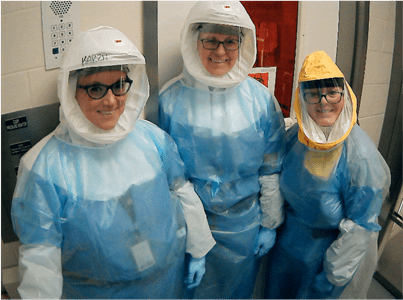INDIANAPOLIS—Researchers in the Department of Orthopaedic Surgery at Indiana University School of Medicine, with support from the Richard L. Roudebush Veterans Affairs Medical Center in Indianapolis, have discovered that SARS-CoV-2 can cause quick and significant bone loss—even when infections are mild.
Mouse models infected with the novel coronavirus that causes COVID-19 lost approximately 25% of their bone mass within two weeks of contagion and exhibited a 63% increase in osteoclasts, the cells that cause bone to break down. These changes were observed even in mice who experienced only mild COVID-19 symptoms and those who were asymptomatic.
The findings are being published in BONE, a journal focused primarily on research into bone and mineral metabolism and the interactions of bone with other organ systems.
The study raises questions about the lasting implications of the pandemic and the virus’s effects on the musculoskeletal system. The discovery will likely inspire further research into the potential bone loss experienced by people of all ages who contract COVID-19.
The study is part of ongoing coronavirus research being conducted by the Kacena Lab in Indianapolis, led by Melissa Kacena, PhD, Vice Chair of Research for the Department of Orthopaedic Surgery.
This year, the Kacena Lab became the first lab in Indiana to begin using mouse models to study the coronavirus, in hopes of learning more about and discovering a treatment for the disease. The lab acquired transgenic mouse models to aid in its experiments, making it only one of a handful of labs in the United States to be conducting coronavirus-related experiments at this level.
Diverting research to SARS-CoV-2 came after several studies revealed that those dying from the coronavirus had high numbers of megakaryocytes built up in various organs, which causes significant issues. Megakaryocytes are among the Kacena Lab’s areas of expertise. Researchers working under Kacena’s mentorship study the cells in relation to bone regeneration and fracture healing.
Kacena’s researchers then began questioning the other effects COVID-19 might be having on the body, particularly the musculoskeletal system. These inquiries ultimately led to the discovery of decreased bone matter in the coronavirus-infected mice.
Decreased bone mass, or osteoporosis, can cause brittle bones that are prone to breaks. Elderly people have always been one of the most at-risk group for complications due to osteoporosis because they are least likely to naturally regenerate lost bone matter. Because the elderly are also at a higher risk of contracting COVID-19, Kacena’s team is studying if those who overcome the virus will now be even more likely to suffer broken bones.
And with more children contracting the Delta variant, further questions are raised about whether young people can develop adequate bones after contracting the virus. Humans don’t reach peak bone mass until approximately age 25, Kacena said, and COVID-19 could be impacting development.
This work was supported by the Indiana Clinical and Translational Sciences Institute, funded in part by NIH UL1TR002529, and by NIH 1U54DK106846 T32DK007519, T32AR065971, and T32HL007910.
This work was also supported in part by VA Merit Review Award #BX003751 from the United States Department of Veterans Affairs Biomedical Laboratory Research and Development Service. The contents do not represent the views of the U.S. Department of Veterans Affairs, the National Institutes of Health, or the United States Government.
###
IU School of MedicineIU School of Medicine is the largest medical school in the U.S. and is annually ranked among the top medical schools in the nation by U.S. News & World Report. The school offers high-quality medical education, access to leading medical research and rich campus life in nine Indiana cities, including rural and urban locations consistently recognized for livability.




